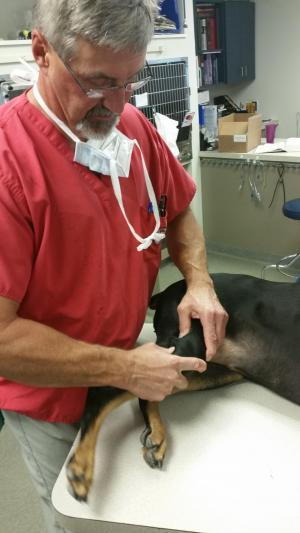Ow! My Knee!
- posted: Oct. 22, 2014

Cranial Cruciate Ligament Tears in Dogs
Football season is upon us with a flurry of fall games. What does this have to do with veterinary medicine, you ask? Well, many dogs actually have an injury that is common in football players known as a cranial (or anterior in people) cruciate ligament tear or “CCL” for short. This injury usually occurs when the dog (or linebacker) is running and twists his knee, but the ligament can also tear secondary to obesity and gradual wear and tear over time. When this ligament tears, it leads to pain and instability in the knee, and the dog will often not use the affected leg. Cats can occasionally have this injury as well, but it is rare. Older, overweight, large breed dogs are at highest risk, and they can often tear both ligaments.
So, what happens if your favorite furry tackler has torn his CCL? In most cases, surgical repair provides the best outcome. Dr. Doug Schmidt has been performing CCL repairs in dogs (and a few cats!) for more than 20 years at Patton Veterinary Hospital. There are several different methods of repair but the two that Dr. Schmidt currently performs are known as a “lateral suture technique” which is an older technique, but still proven to provide good stability in the knee, and the newer “tightrope” method which has been working very well in our patients. The tightrope method is currently considered to be superior to the lateral suture method for large breed dogs.
While the ligament itself cannot be repaired, both of these methods use biomechanics to provide the same type of stability to the joint as the ligament. The repair is not permanent; it only provides long term stability until the body can form scar tissue around the joint to keep it stable.
Both types of surgery use what is known as an extracapsular repair. Thick suture or sterile high-test fishing line outside the joint capsule is used in the lateral suture technique, and a special Fiber Tape is anchored to the bone in the tightrope method.
Total recovery time is about 8-12 weeks and there are strict restrictions on activity and physical therapy exercises that must be followed for optimum outcome. Patton Veterinary Hospital also uses post-operative laser therapy to cut down on swelling, inflammation and pain and to promote faster healing of the incision.
If your dog has hind limb lameness or you feel he may have torn his CCL, contact our staff to schedule a consultation with one of our doctors to see if your dog may benefit from surgical repair with Dr. Schmidt.
Location
Patton Veterinary Hospital
425 E Broadway
Red Lion, PA 17356
